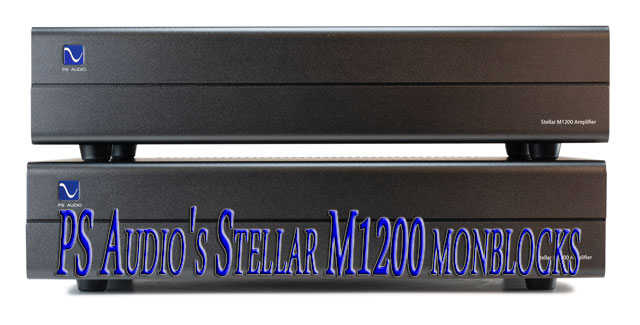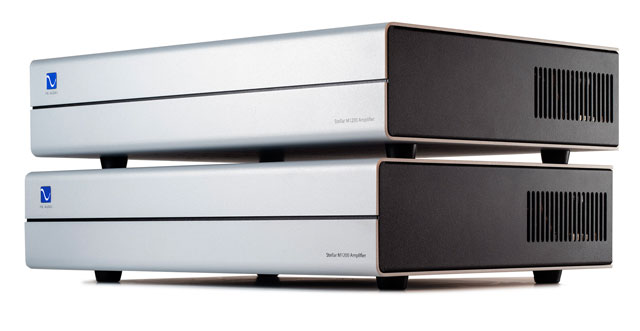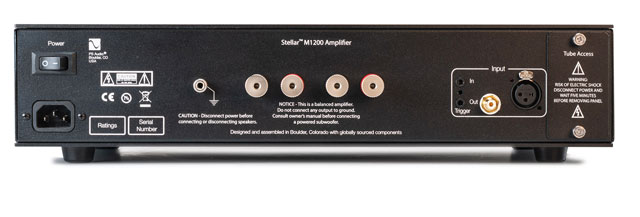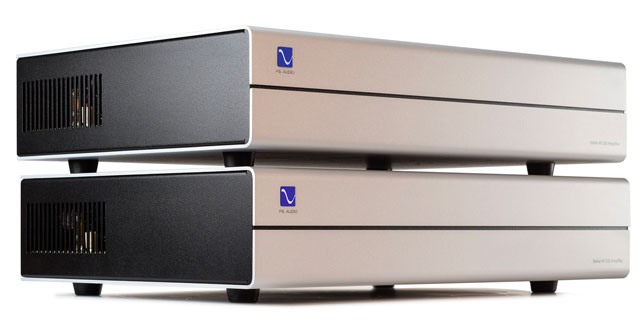PS Audio’s Stellar M1200 monblocks by Richard Willie


Effortless. Detailed. Dynamic. Powerful. Articulate. Clean. Controlled. Musical. Fun. The PS Audio Stellar M1200 Power Amplifiers are more than just good “Class D” amplifiers; they are great amplifiers regardless of the technology employed. With a splash of warmth and color of tubes, the M1200’s have the kind of dynamics that infuse even the most languid music with a spark of excitement. The Stellar M1200 Power Amplifiers have challenged many of the preconceived notions I have held about Class D technology.
Development
I enjoy interviewing the engineers and designers of audio equipment because I often find their insights accurate indicators of how the final product sounds. The way someone talks about developing an amplifier, for instance, whether with passion and enthusiasm (or the lack thereof), clinically or emotionally, or with great interest or apathetic disregard, will often shed light on the amplifier’s sound itself. For this review, I had the opportunity to speak to Darren Myers of PS Audio about the development of the M1200’s as part of this review; the conversation was enlightening.
One of the first things that I noticed about Darren was his passion for music. He exudes excitement and enthusiasm that very clearly communicates a love for what he’s doing, though sadly, not every audio engineer approaches their design in the same way. Darren explained that before working for Bowers & Wilkins and Classé, he had always assumed that every amplifier or speaker designer was a “super listener.” Darren reasoned, “you would be blind if you didn’t have that skill.” But it turns out that most people don’t have the refined listening skills to hone an amplifier design. Although strictly speaking, those skills are not needed to design amplifiers. Darren explained that in many cases, designers use measurements to build the amplifier and rely on other more experienced listeners to tell them how it sounds.
 One of the most valuable skills Darren has developed over the past several years is learning to trust his ears. One part engineer and one part audiophile, Darren often finds himself caught in the crossfire between the ‘objective’ and the ‘subjective.’ Darren explained that in school, he learned a lot about theoretical circuit design; but, circuit design doesn’t necessarily teach engineers to be good listeners. However, this is precisely the skill that Darren finds invaluable during the design process’s refinement stage; amplifier design can indeed be a battle between the head and the heart.
One of the most valuable skills Darren has developed over the past several years is learning to trust his ears. One part engineer and one part audiophile, Darren often finds himself caught in the crossfire between the ‘objective’ and the ‘subjective.’ Darren explained that in school, he learned a lot about theoretical circuit design; but, circuit design doesn’t necessarily teach engineers to be good listeners. However, this is precisely the skill that Darren finds invaluable during the design process’s refinement stage; amplifier design can indeed be a battle between the head and the heart.
Class D amplification lies at the center of one of these battles for Darren. It represents an area of development he became too familiar with during his time at Classé and Bowers & Wilkins. Traditionally, Class D amplifiers have been known for being somewhat forward in their presentation, with a lot of perceived energy in the upper registers (even though they may measure very well). Tonally, they can sometimes come across as grey and a bit overexposed. However, as Darren quickly pointed out, Class D technology has enjoyed rapid advancement in recent years. Since leaving to work for PS Audio, one of his personal goals has been to design a refined Class D product line.
If the development of the M1200 monoblock amplifiers reinforced one thing for Darren, it was the importance of parts selection; even a single resistor can change an amplifier’s entire tonal balance. Developing the M1200’s started with close listening to a variety of Class D modules, classifying them, then building a circuit that would be synergistic with the selected module. The selection of complimentary circuit components was critical to getting the sound of the M1200’s right.
One of the most striking design characteristics of the Stellar M1200 amplifier is the use of a triode gain stage, coupled with a powerful Class D ICEpower output module. Darren is particularly sensitive to tonality and balance in the sound of an amplifier. According to Darren, triodes can add body, boldness, depth, and a certain weight to an amplifier’s sound, something that Class D amplification is often missing.
The best way to imbue a Class D amplifier with a triode’s characteristics is to use a gain device with a triode-like transfer curve. While some transistors can exhibit a tube’s characteristics, tubes will typically have a slightly different sort of transfer curve than transistors. Loosely speaking, only a select few FET transistors exhibit triode-like transfer curve characteristics, while MOSFETs and Bipolar Junction Transistors exhibit pentode-like transfer curve characteristics. However, as Darren explained, “I knew a triode would be very synergistic with a Class D, so I wanted to go right to the real thing.” That is a real triode.
Darren’s initial amplifier design, the Stellar M700, made great use of the “Analog Gain Cell,” comprised of MOSFET transistors. When asked about the difference between the analog cell and the input stage of the M1200’s, Darren explained, “[t]he M1200’s input stage uses a 12AU7 vacuum tube opposed to MOSFETS. When implemented well, a vacuum tube has the correct tonal characteristics I was after in order to create synergy with the Class D output stage. Although the M700’s input stage executes this well, the tube is without a doubt superior in this role.” From the sounds of it, this is a synergistic combination indeed.

Description
As the name implies, the Stellar M1200 power amplifier draws its design inspiration from the rest of the Stellar product line. The M1200’s are 17 inches wide and 3.75 inches tall, weigh in at just under 30 lbs. apiece and come in either black or silver. The M1200’s namesake comes from the 1200 watts that the amplifier can put into 4 Ohms (stable into 2 ohms), with a peak current output of 38 amps and an output impedance of 0.007 ohms. The M1200’s are built with ample headroom in-mind because a lack of headroom (especially in a Class-D amplifier) will highlight the nonlinear distortion that humans are so sensitive to. That said, it would be difficult to find a pair of loudspeakers that the Stellar M1200’s could not drive with authority.
The Stellar M1200’s gain was slightly higher than what I am accustomed to, at 30.5 dB. Despite having a tube input stage, the amplifier itself had a noise floor comparable to almost any completely solid state design I have heard. However, the noise floor of the BHK preamplifier and Directstream DAC are somewhat higher. When paired with my relatively sensitive Tekton loudspeakers, the noise floor from each of these components was more noticeable than with my Pass Labs XA30.8, though not to the point that it was disruptive. As my time with the M1200’s went on, I noticed the Directstream DAC and BHK preamplifier noise floor less and less. Though this design decision is not a problem in itself, it may require careful consideration from the end-user with respect to other system components.

The back panel of the Stellar M1200’s sports RCA and balanced inputs, with two sets of speaker outputs. Also on the back of the amplifiers are access panels for accessing and changing the 12AU7 triode tubes. Once installed and operational, the tubes are lit by a small blue LED that contrasts with the orange triode filaments and is visible through a side grille—a nice bit of eye-candy.
The speaker binding posts are copper-based, nickel coated, and solid in their construction. Though the construction of the speaker binding posts was superb, their horizontal arrangement in conjunction with the amplifiers’ low profile made the use of thick cables with spades a little inconvenient. Aesthetically, I felt the Stellar M1200’s looked better when pushed to the front of my audio rack, but because of the relatively shallow amplifier depth, it left some space on the back end of the audio rack. I use Kimber Monicle X speaker cables. Although they could couple to the binding posts on a horizontal surface, I was a little uncomfortable with the speaker cables’ amount of pressure since they practically had to make a quick 90-degree turn to lock into the M1200 binding posts. I ended up pushing the M1200’s to the back of the audio rack so my cables could hang down to the floor. Cables with banana-plug terminations will have no issue with the binding posts.
Overall, the M1200’s are more than technically capable of handling even the most demanding speaker designs. With the power and headroom that the M1200’s have on tap, they will barely break a sweat in virtually any conceivable home audio situation; though if you wanted to play at rock concert levels, they’d be up for that too.
Setup and Positioning
 This review is somewhat unique because the system I am currently using consists almost entirely of PS Audio components. The system is built on a solid foundation with PS Audio’s DirectStream Power Plant 12, followed by a DirectStream DAC and BHK Signature Preamplifier. My reference amplifier is the capable and well-reviewed Pass Labs XA30.8, which drives a pair of Tekton Design Double Impacts. With the Stellar M1200’s in for review, this system effectively became an all PS Audio chain (except for the loudspeakers).
This review is somewhat unique because the system I am currently using consists almost entirely of PS Audio components. The system is built on a solid foundation with PS Audio’s DirectStream Power Plant 12, followed by a DirectStream DAC and BHK Signature Preamplifier. My reference amplifier is the capable and well-reviewed Pass Labs XA30.8, which drives a pair of Tekton Design Double Impacts. With the Stellar M1200’s in for review, this system effectively became an all PS Audio chain (except for the loudspeakers).
Unlike the Stellar S300, or even the Stellar M700’s, Darren Myers voiced the M1200’s using a Directstream DAC and BHK Preamplifier. Even though the M1200’s bear the “Stellar” moniker, which denotes the company’s midrange offerings, the M1200’s are designed to be used with its top-tier products gives some indications of PS Audio’s assessment of the M1200’s audio performance.
Virtually all of the promotional literature of the M1200’s are shown in a stacked configuration. Most of the initial listening with the M1200’s was in a stacked setup, as it was the most convenient. While stacked, I was able to keep the M1200’s on the same rack as two other amplifiers that I was listening to, which made swapping cables very easy. My initial opinion of the M1200’s was in the stacked configuration, and it was only when I started writing this review once I listened to them side-by-side.
While there are compelling aesthetic reasons to stack the M1200’s, I found that the best sounding position for the M1200’s was side-by-side, with some space between them. While the Stellar M1200’s can be stacked (and arguably they look the best this way), I found they sounded more relaxed and smooth if they have room to breathe, which was how Darren voiced them.
Break-In
A word on break-in. When I took the M1200’s in for review, I was warned that they needed a reasonable amount of time to break-in. The rough estimate needed for break-in was 200 hours. Sage advice.
I’ve listened to every piece of new audio equipment that has benefitted from a certain amount of break-in, some more than others. The M1200’s needed more break-in time than many other amplifiers I’ve listened to. I am glad that PS Audio suggested a 200 hour break-in period, though I would argue that 200 hours is the minimum amount of time that these amps should be run before serious listening.
Out of the box, the M1200’s seemed to sound a bit forward in their presentation, with the mid and high frequencies pushing towards grainy. However, around the magical 200-hour mark, I started to hear significant changes in the mid and upper-frequency ranges. The M1200’s started to relax and smooth out somewhat, and the overall tonality started to warm ever so slightly. As I continued to listen, the once fatiguing sound became more relaxed and inviting.
The M1200’s need significant break-in to sound their best, and some may find it frustrating to wait for 200-to-300 hours, especially if it is only possible to listen to a couple of hours per day. Fortunately, there are a couple of techniques that can accelerate the break-in process. For instance, Darren Myers suggested running the amplifiers during the night with an input signal, but not connected to speakers. This technique exercises the parts of the amplifier that handle voltage swings, though admittedly, the technique would not reach the current output stages. Alternatively, I found that (quietly) playing Max Richter’s “Sleep” throughout the night allowed me to quickly log hours without disturbing my family. Both techniques have their advantages.
Listening
 Surprising. That’s how I would characterize my experience with the Stellar M1200 power amplifiers. I have long gravitated to the sound of tubes and Class A amplification. When I was waiting for the M1200 monoblocks to arrive, I can’t say that I was giddy with excitement like I am with many new audio products because these were, after all, Class-D amplifiers. I had certain expectations about how they would sound, but the tubes were an intriguing twist. Was it possible that PS Audio was trying to create an amplifier with a triode sound signature but with virtually limitless power reserves?
Surprising. That’s how I would characterize my experience with the Stellar M1200 power amplifiers. I have long gravitated to the sound of tubes and Class A amplification. When I was waiting for the M1200 monoblocks to arrive, I can’t say that I was giddy with excitement like I am with many new audio products because these were, after all, Class-D amplifiers. I had certain expectations about how they would sound, but the tubes were an intriguing twist. Was it possible that PS Audio was trying to create an amplifier with a triode sound signature but with virtually limitless power reserves?
The M1200’s were surprising to me because they picked up more of the triode characteristics than I expected them to. On more than one occasion, I have walked away from a completely solid-state (and costly) stereo system thinking it was impressive, but that it had no life to it; that is not how the M1200’s sound. On the contrary, the M1200’s have a certain warmth, with a rich tone that breathes life into the music. “Stale,” “sterile,” and “clinical” are adjectives that never found their way into my review notes.
The M1200’s are detailed, open, effortless in their presentation, and have undoubtedly some of the cleanest, impactful, and most authoritative bass I have heard from an amplifier. At one point, a houseguest commented that the bass guitar in the recording sounded like a real bass guitar; in all honesty, it did. Bass through the M1200’s is controlled and deep, but it also has a resolution in the low frequencies that brings out aspects of music rarely heard through other amplifiers.
Though in all of that, the M1200’s still retain some of the triode characteristics that I really love. Moreover, they have a very energetic and lifelike sound and can easily reproduce the sense of space that makes live recordings sound real. Slow and laid back music primarily benefits from the infusion of life from the M1200’s. Classic rock has all the bass it needs to sound great and doesn’t break up or become harsh when the volume is turned up. Acoustic recordings convey a sense of space around each instrument and within the recording room. The next few tracks are illustrative of this and highlight some of the strengths of the M1200’s.
 Some music is meant to be played loud, and not in a rock and roll sort of way. Something lost in the loudness wars is the role of dynamics in music. Hans Zimmer is one of my favorite film score composers. His composition “Mountains” on Interstellar (Original Motion Picture Soundtrack), released by WaterTower Music, is a perfect example of the use of dynamics. Starting at a gentle pianississimo, this track builds on a slow pulsing rhythm reminiscent of a clock while gently playing in the background. As the track continues, the ticking clock’s pace increases the tension over a long crescendo until it reaches a thundering fortississimo as complex pipe organs, synthesizer sweeps, and massed strings finish out the track. Impressively, the M1200 still seems to keep the pipe organs from turning into a wall of sound and preserving the music’s dimensionality. The M1200’s convey all of this beautifully, as they carefully delineate each layer of music, never breaking apart or becoming harsh, especially in the loudest passages. The sound presented here is effortless with a cavernous sense of space, which I imagine, is precisely what Hans Zimmer had in mind when he composed it.
Some music is meant to be played loud, and not in a rock and roll sort of way. Something lost in the loudness wars is the role of dynamics in music. Hans Zimmer is one of my favorite film score composers. His composition “Mountains” on Interstellar (Original Motion Picture Soundtrack), released by WaterTower Music, is a perfect example of the use of dynamics. Starting at a gentle pianississimo, this track builds on a slow pulsing rhythm reminiscent of a clock while gently playing in the background. As the track continues, the ticking clock’s pace increases the tension over a long crescendo until it reaches a thundering fortississimo as complex pipe organs, synthesizer sweeps, and massed strings finish out the track. Impressively, the M1200 still seems to keep the pipe organs from turning into a wall of sound and preserving the music’s dimensionality. The M1200’s convey all of this beautifully, as they carefully delineate each layer of music, never breaking apart or becoming harsh, especially in the loudest passages. The sound presented here is effortless with a cavernous sense of space, which I imagine, is precisely what Hans Zimmer had in mind when he composed it.
 Acoustic recordings seem to derive significant benefits from the massive overhead that the M1200’s bring to the table. This is beautifully illustrated in the Mats Eilerston Trio’s “And Then Comes The Night” album by ECM. The second track of the record, “Perpetum,” is sparse and airy, with occasional gongs, drums, and other percussive instruments, before adding piano and stand up bass. The M1200’s not only masterfully convey the space around instruments but also space within the recording room. The low bass from drum strikes roll into the listening space, plucked bass notes sound incredibly realistic, while the piano melody floats effortlessly on top of the composition. The M1200’s convey this album with an absolute realism and liveliness that many other amplifiers fall short of.
Acoustic recordings seem to derive significant benefits from the massive overhead that the M1200’s bring to the table. This is beautifully illustrated in the Mats Eilerston Trio’s “And Then Comes The Night” album by ECM. The second track of the record, “Perpetum,” is sparse and airy, with occasional gongs, drums, and other percussive instruments, before adding piano and stand up bass. The M1200’s not only masterfully convey the space around instruments but also space within the recording room. The low bass from drum strikes roll into the listening space, plucked bass notes sound incredibly realistic, while the piano melody floats effortlessly on top of the composition. The M1200’s convey this album with an absolute realism and liveliness that many other amplifiers fall short of.
One of the things that I find unique about PS Audio is its recent expansion into the recording industry with Octave Records. While the Octave Records catalog is modest, PS Audio has been starting to focus more and more on the label and is producing albums with increasing frequency. In PS Audio’s literature, it states: Octave Records is dedicated to offering the highest-quality recordings in high-resolution formats including pure DSD on SACD, DSD Direct Mastered CD, 45-rpm virgin vinyl single-pressings, as well as 192kHz PCM. I asked Paul McGowan a few questions about the newest album and PS Audio’s Octave Records. According to Paul, one of the goals of Octave Records is to help PS Audio “exert a measure of quality/performance control over the entire chain from the musician’s lips to your ears.” I can’t think of very many companies that have tackled such an ambitious goal.
When PS Audio and Octave Records announced its latest release by Clandestine Amigo, I purchased it purely out of curiosity (it was not provided as part of this review). I was pleasantly surprised by the entire album as I started playing it; I didn’t seem to tire or grow bored with this album at all, which appears to be one of the hallmarks of well-recorded music. The track “Enough” starts with soft piano before rolling out a dynamic and velvety smooth bass line, followed by Jessica Carson’s beautiful and realistic vocals. Throughout the entire track, the M1200’s took total control of the bass while unraveling every nuance of this beautiful recording.
Comparisons
I had the good fortune of having two great amplifiers to directly compare the M1200’s with during this review; the Pass Labs XA30.8 and Coda Technologies CSiB, an integrated amplifier (review to follow).
The Pass Labs XA30.8 has been my reference for several years now and comes with its own set of well-documented strengths and weaknesses. The comparison between the XA30.8 and the M1200’s highlighted some of the shortcomings that I expected would be apparent but also revealed a couple that hadn’t jumped out at me before.
When comparing the specifications of the Stellar M1200’s and the Pass Labs XA30.8, two are notable; the power and the damping factor. The M1200’s can output 600 watts at 8 Ohms and have a damping factor of about 1100; the XA30.8 is rated for 30 watts into 8 ohms, with a damping factor of 150. In comparison, the M1200’s tend to be more dynamic top to bottom, with absolute control over the woofers’ movement. The bass of the M1200’s is deep and thunderous, with more resolution than the XA30.8. Comparatively, the XA30.8 has a wetter and thicker bass sound, with a slight mid-bass bump. This was somewhat expected from the difference in specifications.
The Pass Labs also tends to be warmer, lusher, sweeter, more relaxed, and just a little more smooth through the midrange and high frequencies than the M1200’s. The M1200’s are faster, more detailed, and open, overall a bit drier, and can make the XA30.8 sound slightly veiled in direct comparisons. While the M1200’s are not as warm or lush as the XA30.8, I would not characterize it as being cool or neutral either. The characteristics of the triode input shine through and add some warmth and color to the sound. On a scale from neutral to warm, I would characterize the Coda Technologies CSiB as being closest to neutral, with the M1200’s being a little warmer than that, and the Pass Labs the warmest and sweetest sounding of the three I had on hand.
Another striking difference between the XA30.8 and the M1200’s was how they handled loud passages of music. For example, on the Interstellar track referenced above, both amplifiers performed well, but the M1200 had some distinct advantages. When the crescendo of the track hits, the XA30.8 had some difficulty unraveling all of the complexity of the music in what I would describe as a “wall of sound.” When being pushed to the point that the bias needle is starting to dance a bit, there is a slight harshness on the track. The M1200’s in comparison, handle this track with a sense of poise and ease that reveals the complexity and nuance of the track while never becoming harsh or stressed.
The Coda Technologies CSiB is neutral, pure, liquid, and smooth with great bass. While the CSiB does have better bass than the XA30.8, it does not exhibit the control of the M1200’s and cannot recreate a deep cavernous sound to the degree the M1200’s can. While I characterize the CSiB as “neutral,” that’s in terms of warmth, not in a lack of personality. The CSiB retrieves a level of detail that compares with the M1200’s but is more liquid in its presentation than either the XA30.8 or the M1200’s. All three amplifiers are excellent, with three distinctive voices; though, the M1200’s are arguably the most dynamic of the three.
Conclusion
Redefining my opinions of what Class D technology is capable of, the PS Audio Stellar M1200 Power Amplifiers offer a compelling combination of power, detail, warmth, and, notably, excitement. The M1200’s are clear and articulate, with bass that is stunningly detailed, clean, and controlled. My expectations of crushing bass were almost a given after reviewing the M1200’s specifications. However, the warmth, color, and tone of tubes were somewhat unexpected. In short, the PS Audio Stellar M1200 Power Amplifiers are fun and satisfying to listen to and extremely well-rounded performers. At a minimum, they are worth a 30-day risk-free in-home audition.

Richard Willie

Specifications:
Stellar M1200 Mono Amplifier
Price: $5995.00
Unit Weight27 lbs [12.2 kg] (each)
Unit Dimensions17”W x 3.75”H x 12”D (13″D w/connectors)
17”W x 7.5”H x 12”D (Stacked)
Shipping Weight: 29 lbs [13.15 kg] (each)
Shipping Dimensions: 22”W x 8”H x 17”D (each)
Color OptionsBlack
Silver
Vacuum tube type: 12AU7
Voltage Options
(Factory set only): Japan 100V
North America 120V
Europe/Asia/Australia/New Zealand 230V
Website: www.psaudio.com
One thought on "PS Audio’s Stellar M1200 monblocks by Richard Willie"
Leave a Reply
Stereo Times Masthead
Publisher/Founder
Clement Perry
Editor
Dave Thomas
Senior Editors
Frank Alles, Mike Girardi, Russell Lichter, Terry London, Moreno Mitchell, Paul Szabady, Bill Wells, Mike Wright, and Stephen Yan,
Current Contributors
David Abramson, Tim Barrall, Dave Allison, Ron Cook, Lewis Dardick, John Hoffman, Dan Secula, Don Shaulis, Greg Simmons, Eric Teh, Greg Voth, Richard Willie, Ed Van Winkle, Rob Dockery, Richard Doran, and Daveed Turek
Site Management Clement Perry
Ad Designer: Martin Perry









Well, what can I say? An excellent review. One problem I have with audio equipment is the issue of sound by itself vs. comparative sound. To put it as simply as I can, do I want to spend $6000 for M1200s? After this review, yes I certainly do. But what other amplifier(s) could I get for the same $6000? How does the M1200 compare to those?